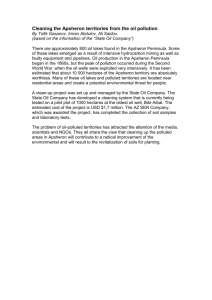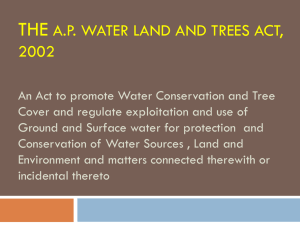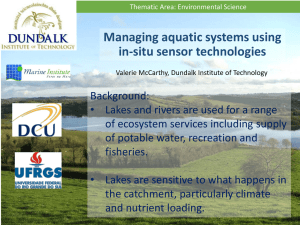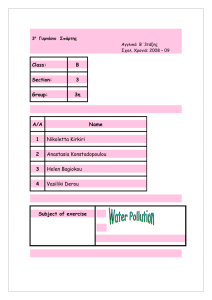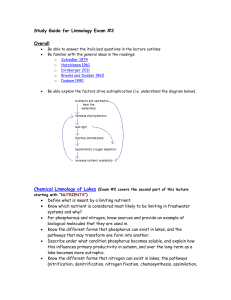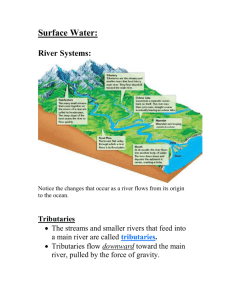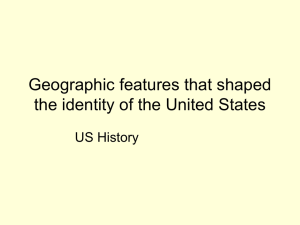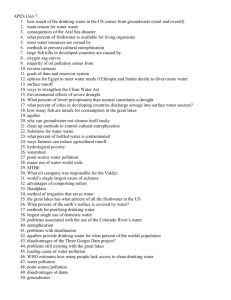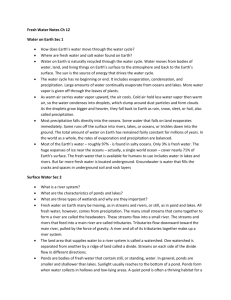Readings – Chapter 4
advertisement
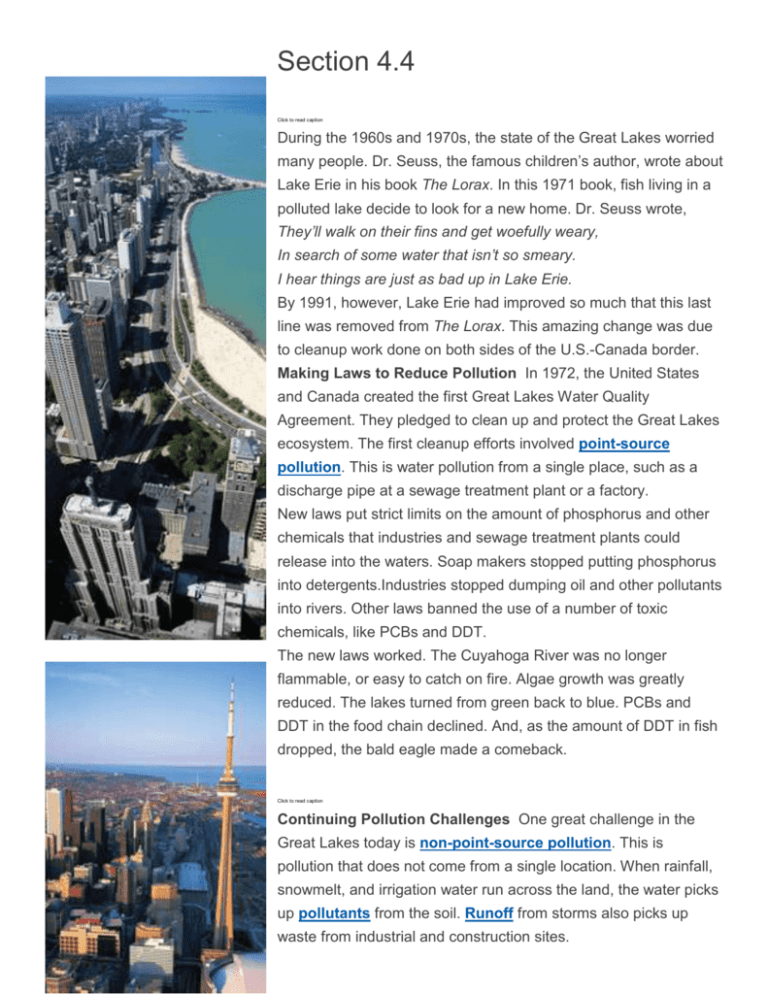
Section 4.4 Click to read caption During the 1960s and 1970s, the state of the Great Lakes worried many people. Dr. Seuss, the famous children’s author, wrote about Lake Erie in his book The Lorax. In this 1971 book, fish living in a polluted lake decide to look for a new home. Dr. Seuss wrote, They’ll walk on their fins and get woefully weary, In search of some water that isn’t so smeary. I hear things are just as bad up in Lake Erie. By 1991, however, Lake Erie had improved so much that this last line was removed from The Lorax. This amazing change was due to cleanup work done on both sides of the U.S.-Canada border. Making Laws to Reduce Pollution In 1972, the United States and Canada created the first Great Lakes Water Quality Agreement. They pledged to clean up and protect the Great Lakes ecosystem. The first cleanup efforts involved point-source pollution. This is water pollution from a single place, such as a discharge pipe at a sewage treatment plant or a factory. New laws put strict limits on the amount of phosphorus and other chemicals that industries and sewage treatment plants could release into the waters. Soap makers stopped putting phosphorus into detergents.Industries stopped dumping oil and other pollutants into rivers. Other laws banned the use of a number of toxic chemicals, like PCBs and DDT. The new laws worked. The Cuyahoga River was no longer flammable, or easy to catch on fire. Algae growth was greatly reduced. The lakes turned from green back to blue. PCBs and DDT in the food chain declined. And, as the amount of DDT in fish dropped, the bald eagle made a comeback. Click to read caption Continuing Pollution Challenges One great challenge in the Great Lakes today is non-point-source pollution. This is pollution that does not come from a single location. When rainfall, snowmelt, and irrigation water run across the land, the water picks up pollutants from the soil. Runoff from storms also picks up waste from industrial and construction sites. Old toxic waste dumps also pollute. Many contain poisons that leak into waterways. There are as many as 250 dumps on the shores of the Niagara River alone. Pollution from the air damages watersheds as well. Mercury, among other things, is released into the air when coal is burned. This highly toxic metal falls back to Earth mixed with rain or as dust. It then enters waterways and the food web. Click to read caption Canada and the United States are working to clean up nonpoint-source pollution. They have made new laws to limit harmful chemicals that go into the air, water, and soil. They are also cleaning up toxic sediment in waterways. Toxic sediment is polluted soil that has settled to the bottom of lakes and rivers. Removing such sediment is both difficult and costly. The best way to deal with pollution is to prevent it. Today, education programs encourage prevention. People in industry and farming are using fewer harmful chemicals. Consumers are also choosing products that are safer for the environment. Section 4.5 Click to read caption Scientists estimate that there are more than 185 invasive species in the Great Lakes today. These are nonnative plants and animals that invade a new ecosystem. The sea lamprey described earlier is one such invader. Most Invaders Arrive by Sea Most invasive species travel to the Great Lakes by water. Some come in the ballast water of ships. Ballast water is water pumped into the bottom of a ship to keep it stable. When the ship arrives at a port, it releases the water. It also releases any creatures in the water. Other invaders, like the zebra mussel, hitch rides on the bottom of ships. Once zebra mussels reach a suitable place, they multiply quickly. Up to 70,000 mussels can thrive in a single square meter of water. Click to read caption Invasive Species Upset the Ecosystem Invaders like the zebra mussel, sea lamprey, and alewife have all damaged the Great Lakes ecosystem. Zebra mussels, for example, steal food from native species. They clog water pipes. They attach to docks and make swimming dangerous because of their sharp shells. The Asian carp is another big threat to the Great Lakes. Catfish farmers in the American South brought this large fish from Asia to clean their ponds. Some carp have escaped into rivers and are migrating toward Lake Michigan. Many people fear that the Great Lakes will someday become giant carp ponds. Canada and the United States are working to prevent more nonnatives from entering the lakes. Shippers are being asked to treat their ballast water more carefully. A barrier has been built to keep non-native fish in the Mississippi River from entering the Great Lakes. Several states have also banned the sale of live Asian carp for fear they will have disastrous effects on the Great Lakes food web. Another approach has been to stock the lakes with species that will eat the invaders.Pacific salmon have been introduced to the Great Lakes to control alewives. Alewife numbers have dropped greatly as a result. And native fish have begun to recover. Section 4.6 Click to read caption A century ago, loggers in the Great Lakes region told folktales of a giant lumberjack named Paul Bunyan. Bunyan was a giant who could cut down a forest in minutes. One tale tells how he scooped out ponds to provide drinking water for his big blue ox, Babe. Today, those ponds are the Great Lakes. In the time of the Paul Bunyan stories, dense forests covered the Great Lakes region.Nobody worried about habitat loss. A habitat is the natural environment in which a plant or an animal lives. But habitat loss is a big worry in the region today. Restoring Forest Habitat When settlers moved into the Great Lakes region in the 1800s, they cleared patches of forest for farms. Later, loggers cut down more trees.Still later more land was cleared for factories and cities. In time, almost half of the region’s original forest was lost to development. When habitats are lost, the plants and animals that live there are often lost as well. Today people are working to reverse forest loss in the Great Lakes watershed. Timber companies are cutting trees in ways that are less harmful to forests. They also replant trees in areas that have been logged. The result is that forests around the Great Lakes are now expanding instead of shrinking. Protecting Precious Wetlands Like forests, wetlands were also lost during the settlement of the Great Lakes region. A wetland is an area where the soil is usually wet all year. Examples are marshes, bogs, and swamps. Wetlands provide habitats for a wide variety of wildlife.They also help to control flooding during storms. In the past, wetlands were viewed as worthless bogs. Over time, more than half of the wetlands in the region disappeared. Only in recent years did people begin to see the value of wetlands habitat. Today, public and private groups are working to protect wetland habitats. One way is by creating nature preserves on existing wetlands.Another is by teaching landowners how to protect wetland areas. In some places, developers must create more than one acre of new wetland for every acre they destroy.
